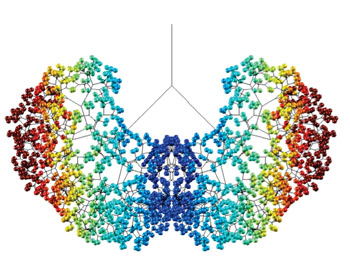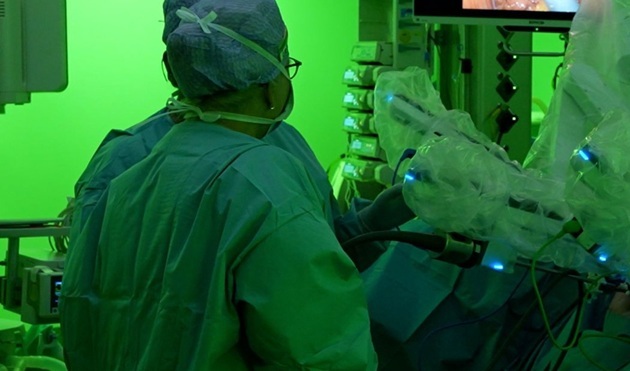Lung Simulations Could Improve Respiratory Treatment
|
By HospiMedica International staff writers Posted on 02 Aug 2015 |

Image: Computer model of SRT delivered to an adult human lung; blue areas receive less (Photo courtesy of Prof. James Grotberg/U-M Engineering).
An innovative computer model that predicts the flow of liquids in human lungs could provide insight into the treatment of acute respiratory distress syndrome (ARDS).
ARDS is a life-threatening inflammation of the respiratory system that kills 74,000 adults each year in the United States alone. It is most common among patients with lung injury or sepsis, a whole-body inflammation caused by infection. Treatment involves surfactant replacement therapy (SRT) to make it easier for the lungs to inflate, similar to the therapy used in premature babies, who can lack the surfactant necessary to expand their lungs. While SRT has contributed to a dramatic reduction in mortality rates of premature babies, the attempt to implement the technology in adults has been largely unsuccessful.
To try and reveal why, researchers at the University of Michigan (U-M; Ann Arbor, USA) and Ecole Polytechnique (Palaiseau, France) developed a mathematical computer model that provided a three-dimensional (3D) image of exactly how SRT flowed through the lungs of patients in the three key trials that examined the technology. The first (1997) clinical study in adults showed promise, cutting mortality rate from 40% to 20%. But two larger studies in 2004 and 2011 showed no improvement in mortality, and the treatment was abandoned.
The computer model used fluid mechanical principals for 3-D modeling of the lung airway tree in both neonates and adults, showing how a liquid plug propagates through the tree from forced inspiration. In two separate modeling steps, they saw that the SRT plug deposits a coating film on the airway wall, and then splits unevenly at the bifurcation due to gravity. The model generates 3D images of the resulting acinar distribution and calculates two global indexes, efficiency and homogeneity.
When the researchers applied this engineering perspective to SRT, they saw one detail that set the successful 1997 study apart; a less concentrated version of medication was used. The SRT used in the 1997 study delivered the same dose of medication as the later studies, but it was dissolved in up to four times more liquid. The additional liquid helped the medication reach the tiny air sacs in the lungs. The study was published on July 13, 2015, in Proceedings of the National Academy of Sciences of the United States of America (PNAS).
“The medication needs to work its way from the trachea to tiny air sacs deep inside the lungs to be effective. This therapy is relatively straightforward in babies but more complex in adults, mostly because adult lungs are much bigger,” said lead author professor of biomedical engineering James Grotberg, MD, PhD, of the U-M College of Engineering. “The modeling technology could be used in other types of research as well, including more precise targeting of other medications in the lungs and projecting results from animal research to humans.”
Related Links:
University of Michigan
Ecole Polytechnique
ARDS is a life-threatening inflammation of the respiratory system that kills 74,000 adults each year in the United States alone. It is most common among patients with lung injury or sepsis, a whole-body inflammation caused by infection. Treatment involves surfactant replacement therapy (SRT) to make it easier for the lungs to inflate, similar to the therapy used in premature babies, who can lack the surfactant necessary to expand their lungs. While SRT has contributed to a dramatic reduction in mortality rates of premature babies, the attempt to implement the technology in adults has been largely unsuccessful.
To try and reveal why, researchers at the University of Michigan (U-M; Ann Arbor, USA) and Ecole Polytechnique (Palaiseau, France) developed a mathematical computer model that provided a three-dimensional (3D) image of exactly how SRT flowed through the lungs of patients in the three key trials that examined the technology. The first (1997) clinical study in adults showed promise, cutting mortality rate from 40% to 20%. But two larger studies in 2004 and 2011 showed no improvement in mortality, and the treatment was abandoned.
The computer model used fluid mechanical principals for 3-D modeling of the lung airway tree in both neonates and adults, showing how a liquid plug propagates through the tree from forced inspiration. In two separate modeling steps, they saw that the SRT plug deposits a coating film on the airway wall, and then splits unevenly at the bifurcation due to gravity. The model generates 3D images of the resulting acinar distribution and calculates two global indexes, efficiency and homogeneity.
When the researchers applied this engineering perspective to SRT, they saw one detail that set the successful 1997 study apart; a less concentrated version of medication was used. The SRT used in the 1997 study delivered the same dose of medication as the later studies, but it was dissolved in up to four times more liquid. The additional liquid helped the medication reach the tiny air sacs in the lungs. The study was published on July 13, 2015, in Proceedings of the National Academy of Sciences of the United States of America (PNAS).
“The medication needs to work its way from the trachea to tiny air sacs deep inside the lungs to be effective. This therapy is relatively straightforward in babies but more complex in adults, mostly because adult lungs are much bigger,” said lead author professor of biomedical engineering James Grotberg, MD, PhD, of the U-M College of Engineering. “The modeling technology could be used in other types of research as well, including more precise targeting of other medications in the lungs and projecting results from animal research to humans.”
Related Links:
University of Michigan
Ecole Polytechnique
Latest Critical Care News
- Soft Robots Could Donate Their Heart to Humans
- Bioadhesive Strategy Prevents Fibrosis Around Device Implants on Peripheral Nerves
- Miniature Non-Invasive Robotic Catheters to Improve Infertility Treatments
- Stick-On Patch Monitors Baby's Movements In Utero
- EEG-Based AI Technology Accurately Diagnoses Alzheimer’s and Dementia
- Robot Lymphatic System Paves Way for Self-Powered Wearables and Machines
- Focused Ultrasound Technique Successfully Treats Pediatric Brain Cancer
- Nasal Drops Fight Brain Tumors Noninvasively
- AI Helps Optimize Therapy Selection and Dosing for Septic Shock
- Glowing Bacteria ‘Pills’ for Detecting Gut Diseases Could Eliminate Colonoscopies
- Skin-Permeable Polymer Patch Delivers Insulin Non-Invasively Through Skin
- Nanogel Technology Almost 100% Effective in Destroying Drug-Resistant Bacteria Within Hours
- Wearable Ultrasound Sensor Delivers Noninvasive Treatment Without Surgery
- Gel-Free ECG System to Transform Heart Health Diagnosis
- Biodegradable Patch Repairs Damaged Tissue After Heart Attack
- Magnetically Guided Microrobots to Enable Targeted Drug Delivery

Channels
Surgical Techniques
view channel
Minimally Invasive Surgery Proven Safe and Effective for Complex ‘Whipple’ Procedure
Tumors of the pancreatic head often require a highly complex operation known as pancreatoduodenectomy or the Whipple procedure. This surgery involves removing multiple structures and creating several internal... Read more
Catheter-Based Procedures Offer Less Invasive Option for Treatment of Valvular Disease
Valvular heart disease, caused by tight or leaky valves between heart chambers, affects up to 10% of older adults and leads to more than 120,000 deaths globally each year. Traditional open-heart surgery... Read morePatient Care
view channel
Revolutionary Automatic IV-Line Flushing Device to Enhance Infusion Care
More than 80% of in-hospital patients receive intravenous (IV) therapy. Every dose of IV medicine delivered in a small volume (<250 mL) infusion bag should be followed by subsequent flushing to ensure... Read more
VR Training Tool Combats Contamination of Portable Medical Equipment
Healthcare-associated infections (HAIs) impact one in every 31 patients, cause nearly 100,000 deaths each year, and cost USD 28.4 billion in direct medical expenses. Notably, up to 75% of these infections... Read more
Portable Biosensor Platform to Reduce Hospital-Acquired Infections
Approximately 4 million patients in the European Union acquire healthcare-associated infections (HAIs) or nosocomial infections each year, with around 37,000 deaths directly resulting from these infections,... Read moreFirst-Of-Its-Kind Portable Germicidal Light Technology Disinfects High-Touch Clinical Surfaces in Seconds
Reducing healthcare-acquired infections (HAIs) remains a pressing issue within global healthcare systems. In the United States alone, 1.7 million patients contract HAIs annually, leading to approximately... Read moreHealth IT
view channel
EMR-Based Tool Predicts Graft Failure After Kidney Transplant
Kidney transplantation offers patients with end-stage kidney disease longer survival and better quality of life than dialysis, yet graft failure remains a major challenge. Although a successful transplant... Read more
Printable Molecule-Selective Nanoparticles Enable Mass Production of Wearable Biosensors
The future of medicine is likely to focus on the personalization of healthcare—understanding exactly what an individual requires and delivering the appropriate combination of nutrients, metabolites, and... Read moreBusiness
view channel
Philips and Masimo Partner to Advance Patient Monitoring Measurement Technologies
Royal Philips (Amsterdam, Netherlands) and Masimo (Irvine, California, USA) have renewed their multi-year strategic collaboration, combining Philips’ expertise in patient monitoring with Masimo’s noninvasive... Read more
B. Braun Acquires Digital Microsurgery Company True Digital Surgery
The high-end microsurgery market in neurosurgery, spine, and ENT is undergoing a significant transformation. Traditional analog microscopes are giving way to digital exoscopes, which provide improved visualization,... Read more
CMEF 2025 to Promote Holistic and High-Quality Development of Medical and Health Industry
The 92nd China International Medical Equipment Fair (CMEF 2025) Autumn Exhibition is scheduled to be held from September 26 to 29 at the China Import and Export Fair Complex (Canton Fair Complex) in Guangzhou.... Read more













